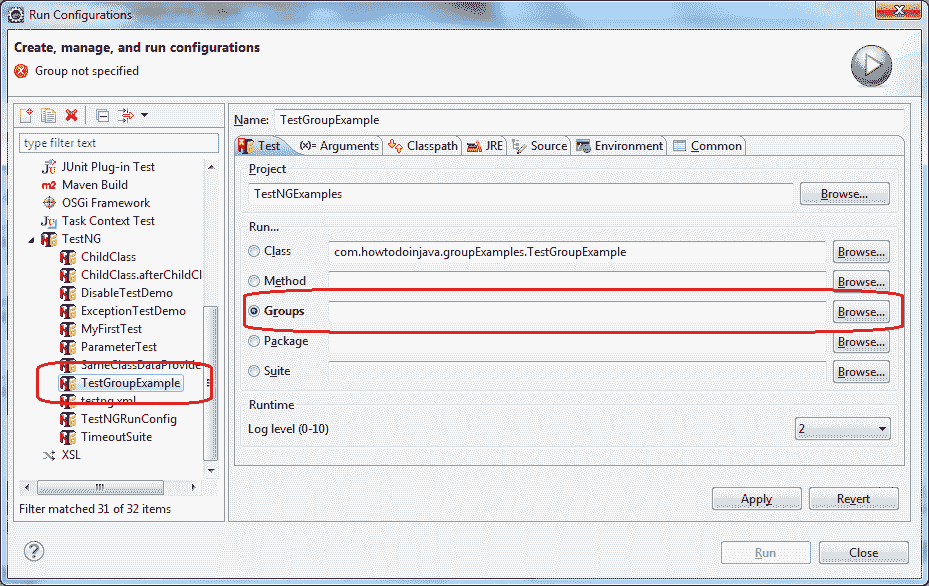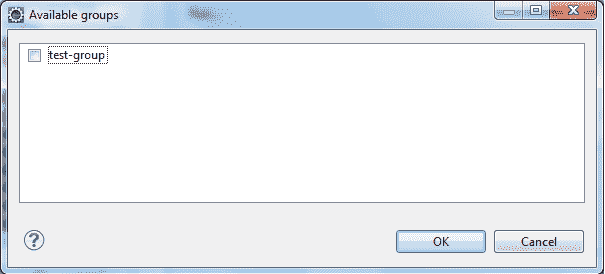TestNG – 测试组,元组,默认组示例
原文: https://howtodoinjava.com/testng/testng-test-groups-meta-group-default-group-examples/
分组测试方法是 TestNG 的最重要功能之一。 在 TestNG 中,用户可以将多种测试方法分组为一个命名组。 您还可以执行属于一个或多个组的一组特定的测试方法。 此功能允许将测试方法分为不同的部分或模块。 例如,您可以拥有一组属于健全性测试的测试,而其他测试则可能属于回归测试。 您还可以根据测试方法验证的功能/特征分离测试。 这有助于在需要时仅执行一组特定的测试。
在本教程中,我们将在以下步骤/部分中了解有关 TestNG 中测试分组的信息。
Table of Contents
Grouping tests example
Running a TestNG group through Eclipse
Running a TestNG group through testng.xml
Writing tests which belong to multiple groups
Including and excluding groups
Using regular expressions
Default group
Group of groups
分组测试示例
让我们创建一个测试类,其中包含属于某个组的某些测试方法。
package com.howtodoinjava.groupExamples;
import org.testng.annotations.Test;
public class TestGroupExample
{
@Test(groups = { "test-group" })
public void testMethodOne() {
System.out.println("Test method one belonging to group.");
}
@Test
public void testMethodTwo() {
System.out.println("Test method two not belonging to group.");
}
@Test(groups = { "test-group" })
public void testMethodThree() {
System.out.println("Test method three belonging to group.");
}
}
如果您将在 eclipse 中正常运行上述测试,则测试执行将不考虑要执行的组,因此将执行指定测试类中的所有测试。 如果只想在某个特定组下执行方法,则将以以下两节中讨论的任一种方式执行它们。
通过 Eclipse 运行 TestNG 组
在前面的部分中,我们创建了一个测试类,其中包含属于测试组的某些测试方法。 现在,让我们使用 Eclipse 运行测试组。
| 1)**转到“运行 | 运行配置”** |
2)从可用配置列表中选择 TestNG,然后单击“新的配置”图标。
3)在新的配置窗口中,提供配置名称,例如TestGroupExample。
4)转到项目部分,然后单击“浏览”按钮。 选择先前创建的项目,即TestNGExamples。

5)转到“分组”部分,然后单击“浏览”按钮。 从列表中选择要执行的组,在这种情况下为测试组。

6)单击“应用”按钮,然后单击“运行”。 以下结果将显示在 Eclipse 的 TestNG 的“结果”窗口中:
Test method one belonging to group.
Test method three belonging to group.
PASSED: testMethodOne
PASSED: testMethodThree
===============================================
GRP-test-group
Tests run: 2, Failures: 0, Skips: 0
===============================================
恭喜,您已经使用 Eclipse 中的 TestNG 运行器配置成功执行了属于特定组的测试方法。 您还可以通过在“浏览”部分中选择相应的组来使用该工具执行多个组。 通常,最好使用基于 TestNG-XML 的执行来执行属于特定组的测试方法。
通过testng.xml运行 TestNG 组
现在让我们学习如何创建一个 testng XML 文件来执行属于特定组的测试方法。 此方法是执行组的首选且简便的方法。 而且,这些 testng XML 文件然后可以与构建工具一起使用以执行 TestNG 测试套件。
1)打开 Eclipse 并在先前创建的项目中创建一个名称为testng.xml的新文件。
2)在上述文件中添加以下代码:
<suite name="Time test Suite" verbose="1">
<test name="Group Test">
<groups>
<run>
<include name="test-group" />
</run>
</groups>
<classes>
<class name="com.howtodoinjava.groupExamples.TestGroupExample" />
</classes>
</test>
</suite>
该 xml 文件在套件中仅包含一个测试。 它包含通过使用groups标记定义的groups部分,如代码所示。 运行标签表示需要运行的组。 include标记代表需要执行的组的名称。
3)选择先前创建的 testng XML 文件并将其作为 TestNG 套件运行。 您将看到以下测试结果:
Test method one belonging to group.
Test method three belonging to group.
===============================================
Time test Suite
Total tests run: 2, Failures: 0, Skips: 0
===============================================
很棒。 我们成功创建了一个 testng XML 文件,该文件中包含一个组,从而在上述套件中创建了一个测试。 这是通过将上述组包含在运行部分中来完成的。 运行部分又是测试内部groups标签部分的一部分。 TestNG 将在测试的类部分中提到的类下查找属于该组的测试方法。 用户还可以提供测试包。 TestNG 将搜索添加到测试中的所有类,以包括或排除属于特定组的特定测试方法。 一旦找到,这些测试方法将由 TestNG 作为测试套件执行。
编写属于多个组的测试
之前我们了解了创建属于单个组的测试的方法,但是 TestNG 允许测试方法也属于多个组。 这可以通过在@Test注解的groups属性中以数组形式提供组名称来完成。 让我们创建一个包含多个小组的示例程序,以了解其操作方法。
package com.howtodoinjava.groupExamples;
import org.testng.annotations.Test;
public class MultiGroupExample
{
@Test(groups = { "group-one" })
public void testMethodOne() {
System.out.println("Test method one belonging to group.");
}
@Test(groups = { "group-one", "group-two" })
public void testMethodTwo() {
System.out.println("Test method two belonging to both group.");
}
@Test(groups = { "group-two" })
public void testMethodThree() {
System.out.println("Test method three belonging to group.");
}
}
上一类包含三种测试方法。 其中两种测试方法分别属于一组,其中一种方法属于两组,分别是第一组和第二组。
现在,编辑testng.xml文件,如下所示:
<suite name="Multi Group Suite" verbose="1">
<test name="Group Test one">
<groups>
<run>
<include name="group-one" />
</run>
</groups>
<classes>
<class name="com.howtodoinjava.groupExamples.MultiGroupExample" />
</classes>
</test>
<test name="Group Test two">
<groups>
<run>
<include name="group-two" />
</run>
</groups>
<classes>
<class name="com.howtodoinjava.groupExamples.MultiGroupExample" />
</classes>
</test>
</suite>
前面的 testng XML 套件包含两个测试,每个测试都执行属于特定组的测试方法。 选择 testng XML 文件并将其作为 TestNG 套件运行。 您将看到以下测试结果:
Test method one belonging to group.
Test method two belonging to both group.
Test method three belonging to group.
Test method two belonging to both group.
===============================================
Multi Group Suite
Total tests run: 4, Failures: 0, Skips: 0
===============================================
在这里,我们成功创建了一个测试方法,该方法属于多个组并且可以成功执行。 如您在先前的测试结果中看到的,在测试套件的两个测试中都执行了testMethodTwo()。 这是因为它属于两个由 TestNG 执行测试方法的组。
包括和排除组
TestNG 还允许您从测试执行中包括和排除某些组。 这有助于仅执行一组特定的测试,而排除某些测试。 一个简单的例子是某个功能损坏时,您需要从执行中排除一组固定的测试,因为这些测试将在执行时失败。 修复功能之后,您可以通过执行相应的测试组来验证功能。
让我们创建一个示例程序,并学习如何排除一组测试。
package com.howtodoinjava.groupExamples;
import org.testng.annotations.Test;
public class ExcludeGroupTest
{
@Test(groups = { "include-group" })
public void testMethodOne() {
System.out.println("Test method one belonging to include group.");
}
@Test(groups = { "include-group" })
public void testMethodTwo() {
System.out.println("Test method two belonging to include group.");
}
@Test(groups = { "include-group", "exclude-group" })
public void testMethodThree() {
System.out.println("Test method three belonging to exclude/include groups.");
}
}
上一类包含三种测试方法,这些方法在执行时将消息打印到控制台上。 这三种方法都属于组include-group,而testMethodThree()方法也属于组exclude-group。
<suite name="Exclude Group Suite" verbose="1">
<test name="Exclude Group Test">
<groups>
<run>
<include name="include-group" />
<exclude name="exclude-group" />
</run>
</groups>
<classes>
<class name="com.howtodoinjava.groupExamples.ExcludeGroupTest" />
</classes>
</test>
</suite>
现在在testng.xml文件上方运行,它将产生以下结果。
Test method one belonging to include group.
Test method two belonging to include group.
===============================================
Exclude Group Suite
Total tests run: 2, Failures: 0, Skips: 0
===============================================
从先前的测试结果中可以看出,TestNG 执行了组include-group中的两种方法,并排除了属于组exclude-group的第三种方法,它从测试执行中排除。
如果测试方法既属于包含组又属于排除组,则排除组具有优先权,并且该测试方法将从测试执行中排除。
使用正则表达式
在将测试配置为包含或排除组时,TestNG 允许用户使用正则表达式。 这类似于包含和排除我们前面介绍的测试方法。 这可以帮助用户根据名称搜索包含和排除组。
让我们学习如何排除基于基于正则表达式的名称匹配的测试。
package com.howtodoinjava.groupExamples;
import org.testng.annotations.Test;
public class RegularExpressionGroupTest
{
@Test(groups = { "include-test-one" })
public void testMethodOne() {
System.out.println("Test method one");
}
@Test(groups = { "include-test-two" })
public void testMethodTwo() {
System.out.println("Test method two");
}
@Test(groups = { "test-one-exclude" })
public void testMethodThree() {
System.out.println("Test method three");
}
@Test(groups = { "test-two-exclude" })
public void testMethodFour() {
System.out.println("Test method Four");
}
}
和testng.xml文件。
<suite name="Regular Exp. Group Suite" verbose="1">
<test name="Regular Exp. Test">
<groups>
<run>
<include name="include.*" />
<exclude name=".*exclude" />
</run>
</groups>
<classes>
<class name="com.howtodoinjava.groupExamples.RegularExpressionGroupTest" />
</classes>
</test>
</suite>
前面的 XML 包含一个简单的测试,其中包含名称以include开头的所有组,而名称以exclude结尾的所有组都从测试执行中排除。
现在运行testng.xml文件,您将在控制台中获得以下结果。
Test method one
Test method two
===============================================
Regular Exp. Group Suite
Total tests run: 2, Failures: 0, Skips: 0
===============================================
在此,TestNG 执行了两个名称以include开头的组的方法,并排除了名称以exclude结尾的组的测试方法。
要使用正则表达式包含和排除组,必须使用.*来匹配名称。 通过在搜索字符串的开头和结尾使用表达式(例如,.*name.*),我们也可以将其用于搜索名称中包含某个字符串的组。
分配默认组
有时我们可能需要将默认组分配给属于一个类的一组测试方法。 这样,属于所述类的所有公共方法将自动成为 TestNG 测试方法,并成为所述组的一部分。
这可以通过在类级别使用@Test注解并在所述@Test注解中定义默认组来实现。
@Test(groups={"default-group"})
public class DefaultGroup {
public void testMethodOne(){
System.out.println("Test method one.");
}
public void testMethodTwo(){
System.out.println("Test method two.");
}
@Test(groups={"test-group"})
public void testMethodThree(){
System.out.println("Test method three.");
}
}
组中组或“元组”
TestNG 允许用户从现有组中创建组,然后在创建测试套件时使用它们。 您可以通过包含和排除某些组来创建新组,然后使用它们。
让我们创建一个示例测试程序,并学习如何创建称为元组的组中组。
package com.howtodoinjava.groupExamples;
import org.testng.annotations.Test;
public class RegularExpressionGroupTest
{
@Test(groups = { "include-test-one" })
public void testMethodOne() {
System.out.println("Test method one");
}
@Test(groups = { "include-test-two" })
public void testMethodTwo() {
System.out.println("Test method two");
}
@Test(groups = { "test-one-exclude" })
public void testMethodThree() {
System.out.println("Test method three");
}
@Test(groups = { "test-two-exclude" })
public void testMethodFour() {
System.out.println("Test method Four");
}
}
现在创建testng.xml文件,如下所示:
<suite name="Group of group Suite" verbose="1">
<test name="Group of group Test">
<groups>
<define name="include-group">
<include name="include-test-one" />
<include name="include-test-two" />
</define>
<define name="exclude-group">
<include name="test-one-exclude" />
<include name="test-two-exclude" />
</define>
<run>
<include name="include-group" />
<exclude name="exclude-group" />
</run>
</groups>
<classes>
<class name="com.howtodoinjava.groupExamples.RegularExpressionGroupTest" />
</classes>
</test>
</suite>
这里在测试内部定义了两组,然后将这些组用于测试执行。 使用groups标签内的define标签创建元组。 使用define标签下的name属性定义新组的名称。 通过使用include和exclude标签从新组中排除组。
现在运行testng.xml测试,它将在控制台中产生以下结果:
Test method one
Test method two
===============================================
Group of group Suite
Total tests run: 2, Failures: 0, Skips: 0
===============================================
在这里,testNG 仅执行两种方法,如在include-group组中提到的,并排除了属于exclude-group的测试方法。 您可以根据需要定义任意多个组。
此功能有助于为回归,健全性和模块测试创建特定的组。
这些都与 TestNG 中的测试组有关。 让我知道您是否有任何疑问。
学习愉快!